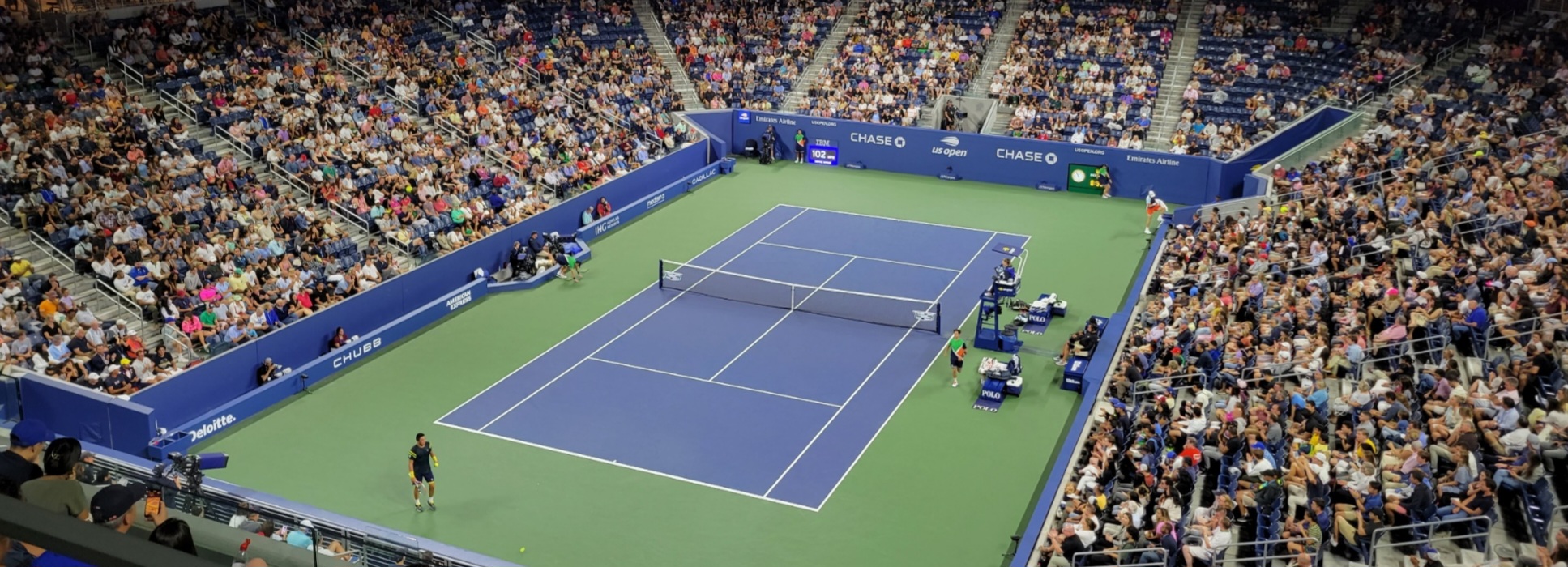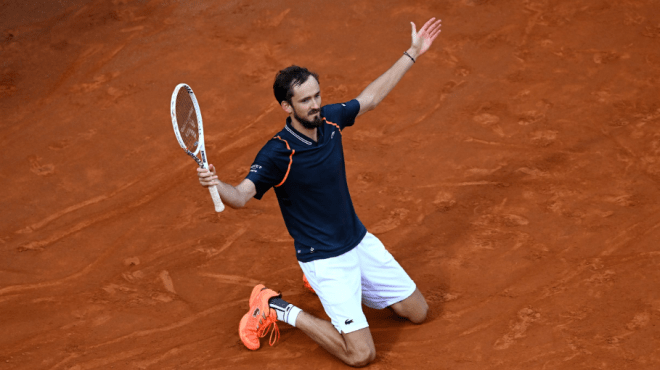Clay-court tennis is known for its slow bounces, defensive court positions, and long rallies. Still, a whole lot of points are determined by the bang-bang, plus-one tactics that define the modern game.
The first week of this year’s European clay season was a wake-up call. The champions in Estoril, Houston, and Marrakech were Hubert Hurkacz, Ben Shelton, and Matteo Berrettini, hardly a trio of counterpunching grinders. In Estoril, 70% of Hubi’s serve points ended in four shots or less–and he won 83% of them. In Houston, three-quarters of Shelton’s ended so quickly, and runner-up Frances Tiafoe’s serve points were even shorter. Berrettini finished 77% of his serve points in four shots or less, winning 76% of them. In other words, the Italian won nearly 60% of his serve points with his serve and plus-one alone.
Tournaments since then have settled into something closer to the stereotype. Marton Fucsovics outlasted Mariano Navone in a Bucharest slugfest. The Munich final was decided between two big hitters, Taylor Fritz and Jan-Lennard Struff, but Struff secured the victory with far fewer short serve points than Berrettini and company.
Yet quick points have an outsized effect on clay-court outcomes. When Stefanos Tsitsipas beat Casper Ruud in Monte Carlo, he finished nearly 70% of his serve points in four shots or less–a Hurkaczian performance befitting a server of his caliber. A week later in Barcelona, the relevant number fell to 63%, not much better than tour average on the surface. Stef found himself exposed, fighting out more rallies against one of the game’s best baseliners. He was broken three times and lost in straights.
Fans tend to look at rally-length stats and focus on winning percentage. How did Jannik Sinner fare on points between 0 and 4 shots? Did Carlos Alcaraz win more than half of 10-plus-shot rallies? While these sliced-up winning percentages matter, you can often tell more about a match–including the likely victor–by looking at the frequency of point types. When Berrettini finishes so many of his serve points quickly, his game is working as intended, and he’s probably winning. If he’s spending more time in long rallies, his opponent has more chances to dictate play, hinting at the opposite outcome.
On clay, then, the battle is to survive, to drag the server into a rally. Nobody on tour does that better than Daniil Medvedev.
Octopus on dirt
In the typical men’s clay-court match, 61% of points end in four strokes or less. That’s based on Match Charting Project data since 2015, spanning over 200,000 clay-court points. Here’s how the returner fares in each type of rally:
Frequency Win %
Short (0-4) 61.2% 33.1%
Medium (5-9) 27.5% 35.3%
Long (10+) 11.2% 55.8%
The longer the rally, the better the returner’s chances, even if the process is gradual. Five- and six-shot rallies still lean in the server’s direction, though not as much as shorter ones. Ten-plusses are effectively neutral. They look slightly returner-friendly because rallies of exactly ten shots are won by the returner, and that’s the most frequent length in the ten-plus bucket. (If we drew the line at nine or eleven, we’d have the opposite problem.)
Now check out Medvedev:
Frequency Win %
Short (0-4) 52.5% 35.5%
Medium (5-9) 30.3% 36.1%
Long (10+) 17.2% 52.3%
The short- and medium-point winning percentages are a bit better, but the real story is in the frequency column. The average match has about 80 serve points for each player. In that time, Medvedev erases about seven short points and adds about five long ones.
In this sense, being a good returner isn’t about cracking return winners or wrong-footing the server. The goal is simply to stay alive. Get the return back, preferably placed well-enough to take away a high-percentage plus-one winner. In last year’s Rome final, Medvedev dragged Holger Rune into long service points almost exactly in line with his career averages: 54% short points, 31% mediums. Rune did just fine through those first nine shots. But when Medvedev reached the ten-shot mark–10 times in 67 Rune service points–he snatched away all but one. Two of those long points gave Medvedev a break for the first set; another 22-shot gutbuster secured the break when Rune failed to serve out the second set.
The Russian’s defense is even more impressive when we compare him to men with better clay-court pedigrees. Here are the top 20 players (minimum 500 charted clay-court return points since 2015) ranked by frequency of short return points:
Player Frequency Win %
Daniil Medvedev 52.5% 35.5%
Diego Schwartzman 53.5% 36.5%
Rafael Nadal 54.7% 39.5%
Alex de Minaur 54.9% 31.2%
David Ferrer 55.1% 34.6%
Marton Fucsovics 55.6% 41.8%
Andy Murray 55.6% 40.0%
Novak Djokovic 55.7% 36.4%
Gael Monfils 55.8% 34.7%
Francisco Cerundolo 55.8% 38.6%
Stefanos Tsitsipas 56.1% 31.8%
Jannik Sinner 56.9% 36.0%
Jaume Munar 57.0% 36.5%
Hubert Hurkacz 57.1% 30.3%
Alexander Zverev 57.5% 34.8%
Alejandro Davidovich Fokina 58.3% 33.7%
Sebastian Baez 58.3% 36.3%
Gilles Simon 58.6% 35.9%
Dominic Thiem 58.6% 32.5%
Guido Pella 58.8% 35.1%
The entire list is packed in a range of about six percentage points, so the full point between Medvedev and Diego Schwartzman–not to mention the two-plus points between him and Rafael Nadal–illustrates just how much of an outlier he is. A low frequency isn’t necessarily better: I’d take Rafa’s combination of frequency and winning percentage over Medvedev, just as I’m sure you would have before reading the first word of this article. But while the Russian doesn’t pick off as many short return points as Nadal, Andy Murray, or Fucsovics(?), his conservatism is hardly a liability. He wins nearly as many as Schwartzman, Sinner, or Novak Djokovic. All this despite a game style tailored to neutralizing the rally further down the line.
The ten-point truth
Medvedev’s long-rally domination of Rune can be misleading. As we’ve seen, he wins about half of clay-court return points that reach ten strokes. Most players do. The benefit of generating long rallies isn’t to sweep the lot: Nobody comes close to accomplishing that, as we will see. The goal is to neutralize rallies. The average server wins 64% of clay-court points, so anything the returner can do to increase the number of 50/50 points is a good deal.
There may be a knock-on effect, as well. Wear out the server, and he might not have as much energy for the next delivery. He might also take more risks in an attempt to end the next points quickly.
The best baseliners don’t need a knock-on effect. Medvedev excels at creating long points, but other men are much better at securing those rallies for themselves. Here are the top 20 among players with at least 100 charted long return points:
Player Long Points Win %
Kei Nishikori 141 69.5%
David Ferrer 129 67.4%
Nicolas Jarry 126 65.1%
Rafael Nadal 863 62.9%
Gilles Simon 121 62.0%
Philipp Kohlschreiber 133 60.9%
Aljaz Bedene 167 60.5%
Richard Gasquet 116 60.3%
Andrey Rublev 271 60.1%
Roberto Carballes Baena 158 60.1%
Carlos Alcaraz 381 60.1%
Botic van de Zandschulp 210 60.0%
Robin Haase 142 59.2%
Sebastian Baez 284 59.2%
Borna Coric 164 59.1%
Pablo Carreno Busta 203 58.6%
Lorenzo Musetti 144 58.3%
Novak Djokovic 1099 58.0%
Alexander Zverev 793 57.9%
Juan Martin del Potro 168 57.7%
(Nicolas Jarry?!)
That’s a very different list than what we saw above. The skills required to stretch out a rally are not quite the same as those needed to finish them off. The ideal, then, is a player who balances the two. Kei Nishikori’s win percentage is excellent, but Medvedev is nearly twice as likely to push any given return point to the ten-shot mark. Jarry plays ten-shot rallies on return less than one-third as often as the Russian does.
The key is to think in marginal terms. Longer points work in the returner’s favor, so we can think of every long point as a medium point that the returner successfully extended. The average player increases his chance of winning a rally by 21 percentage points (from ~35% to ~56%) by nudging it from “medium” to “long.” Call that the “marginal value” of a long rally. When we multiply a player’s marginal long-rally value with his frequency of generating long rallies, we get the total payoff of this defensive skill. The average player reaches ten shots about 11% of the time, so their payoff is 21% * 11% = 2.3%. It’s not a meaningful number on its own, but it provides a reference point for individual stats. If a returner’s payoff is higher, they get more benefit than average from their ability to generate long rallies.
Here’s the top 20 (plus a few other players of note), as measured by this combination of long-rally frequency and success rate:
Player Long Pts Freq MargValue Payoff
David Ferrer 129 14.2% 30.5% 5.3%
Roberto Carballes Baena 158 14.1% 29.0% 4.4%
Gilles Simon 121 14.7% 35.5% 3.9%
Aljaz Bedene 167 12.6% 31.2% 3.7%
Lorenzo Sonego 131 11.7% 23.0% 3.6%
Pablo Carreno Busta 203 13.0% 31.7% 3.5%
Robin Haase 142 11.5% 28.7% 3.5%
Rafael Nadal 863 14.4% 39.8% 3.3%
Novak Djokovic 1099 16.2% 37.5% 3.3%
Stefanos Tsitsipas 558 13.3% 32.4% 3.2%
Juan Martin del Potro 168 12.6% 32.1% 3.2%
Marton Fucsovics 137 16.0% 31.7% 3.1%
Diego Schwartzman 751 17.3% 37.7% 3.1%
Alexander Zverev 793 13.0% 36.0% 2.8%
Daniil Medvedev 394 17.2% 36.1% 2.8%
Richard Gasquet 116 10.5% 34.0% 2.8%
Kei Nishikori 141 9.6% 41.0% 2.7%
Dominic Thiem 931 13.2% 34.9% 2.7%
Holger Rune 185 11.1% 33.3% 2.7%
Cameron Norrie 103 10.0% 29.5% 2.7%
Player Long Pts Freq MargValue Payoff
Jannik Sinner 352 12.9% 38.5% 2.4%
…
Andy Murray 299 12.5% 33.1% 2.3%
AVERAGE 2.3%
…
Casper Ruud 560 9.3% 35.9% 1.7%
…
Carlos Alcaraz 381 8.4% 41.7% 1.5%
Nicolas Jarry 126 5.6% 38.4% 1.5%
…
Stan Wawrinka 193 8.4% 36.2% 1.4%
We have additional evidence, then, that David Ferrer is the 79th best player of the last century. These numbers might even understate his long-rally prowess, since I’ve limited this analysis to 2015-present. The timeframe probably hurts Nadal as well. Also, there aren’t many long points, so the small sample makes the top of the list somewhat misleading: I’m certainly not ready to take Lorenzo Sonego’s long-rally skills over most of the guys below him on the list.
Caveats aside, we have a plausible estimate of how much value each player reaps from his ability to drag servers into long rallies. Ruud and (especially) Alcaraz are very good past the ten-shot mark, but they don’t get there very often. Medvedev remains our king of negating short service points and creating long ones, but many of his peers are better at working a marathon rally to their own advantage.
No matter how we order the list, the key takeaway is that frequency is as important as win percentage. Returners rarely have a chance to finish points early, so extending the rally is almost always a positive step. Do that a lot, and you don’t have to convert a particularly high rate of those long points. Medvedev doesn’t, and he has become one of the tour’s best players on his least favorite surface. Annoyingly often, he breaks serve simply by putting one more ball in play.
* * *
Subscribe to the blog to receive each new post by email:
The post Daniil Medvedev’s Instinct For Survival appeared first on Heavy Topspin.

